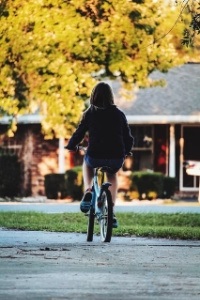
Every year, more than a million students start or return to school during August and September in New York.
But safely getting your kids to school actually affects every one of us who sharethe roads with them. And, by the way, safely sharing the road with young children is a year-round thing, not just something for the start of the school year.
Whether you're a parent, a student who drives, a driver who just happens to be out on our highways at school times, a cyclist, or even a pedestrian, it's your responsibility to watch out for our kids or your kids.
That means being on maximum alert for dangers inside your own vehicle, outside school gates and on sidewalks -- as well as on the roads themselves. It also means obeying school bus laws.
The hazards are everywhere. As well as students who travel by car and bus, about 13 percent of kids either walk or bicycle to school. Afternoons are particularly dangerous, according to AAA.
Want to stay safe and reduce the risk of accidents? Here are some tips to follow.

Driving Safety Tips
If you're driving yourself or others to school, allow yourself plenty of time so you don’t have to rush.Plus:
- Always obey speed limits, parking restrictions and crosswalk rules. Driving slowly significantly reduces the chances of a serious or even fatal accident.
- At stop signs, STOP! Sounds obvious but research shows one third of drivers just slow and then roll through "Stop" intersections.
- Avoid distractions inside your car. No texting, phone calls or mobile breakfasts. And quiet your passengers so you can concentrate.
- If you have to reverse, take extra care. In a difficult situation, get another responsible adult to keep lookout for you.
Make sure all your passengers are wearing their seat belts before moving off. According to New York State law, any child under 4 must be in a federally-approved child safety seat, even if the child is riding in a school bus.
Sharing the Road with Young Children
The younger a student is, the more likely they are to be involved in an accident, especially when they're getting on or off a school bus or if they're walking near a bus. They may be hit by the bus or by a driver illegally passing a stopped bus.
If you're a driver, never pass a vehicle that has stopped for pedestrians. If you're not sure why the car in front has stopped, don’t take a chance. Also:
- If you're stopped at a red light or waiting to turn, don’t block the crosswalk.
- When hazard flashers are blinking in a school zone, follow the speed restrictions and yield to people on the crosswalk. Same goes for when you see a crossing guard with a stop sign.
- Keep your eyes peeled for children playing on the sidewalks or in nearby playgrounds and parks.
- When you're passing parked vehicles, watch out for children darting out from between them.
- Even when you think you have right of way, remember that kids don’t always know or follow the rules. So, beware -- and show courtesy!
Don’t reserve caution just for school zones either. Watch out for boisterous children at school bus stops in your neighborhood too.

Share the Road with Buses
Everyone should know the rules about stopping for a school bus. Quite simply, it's illegal to pass a bus on either side of a road when it has stopped to load or unload children. In New York, this includes school buses that are on the opposite sides of divided highways, on multiple lane roadways, in parking lots and on school grounds.
If the yellow or red lights flash and the stop arm is extended, you must stop.
The National Safety Council says the area 10 feet around the bus is the most dangerous.
For the record, if you ignore a school bus stop signal in New York, you could face up to 180 days in jail and a fine of up to $1,000.
National School Bus Safety Week is October 16 - 20 this year. The theme is "Stop on Red". Enough said!

Watch Out for Cyclists!
Bicycles can be hard to see, especially if they are darkly painted and the rider is wearing dark clothes. So:
- Watch carefully for bicyclists near schools.
- Pass them slowly, leaving at least three feet between you and then.
- If you're about to turn across the path of a cyclist, make sure you have lots of time and space. If in doubt, let them pass.
- Be alert for cyclists come off driveways or sidewalks, or suddenly appearing from behind parked cars.
- Check your side mirrors before you open your car doors.
Dropping Kids off at School
According to the National Safety Council, more children are hit by cars near schools than any other location. An estimated 25,000 children are injured in school zones in the US every year. 100 lose their lives. So:
- Every school usually has its own drop-off rules; make sure you know them and obey them.
- Avoid double-parking -- it interferes with visibility.
- Don’t unload or load children on the other side of the street, forcing them to cross. If there's absolutely no alternative, make sure you cross the street with them.
- Consider carpooling to cut the number of vehicles at the school -- but make sure you trust other motorists who may be driving your kids. Share this blog with them.
Final Words
There are two more important things you should do to protect yourself and others when driving:
1. If you have a teen who is driving to school, show them a copy of the tips in this blog.
2. Make sure you're fully insured. School zones are a high-risk area for accidents. Even with absolute vigilance, you might still get caught out. If you want to check that you're properly insured, speak to Newbridge Coverage.

